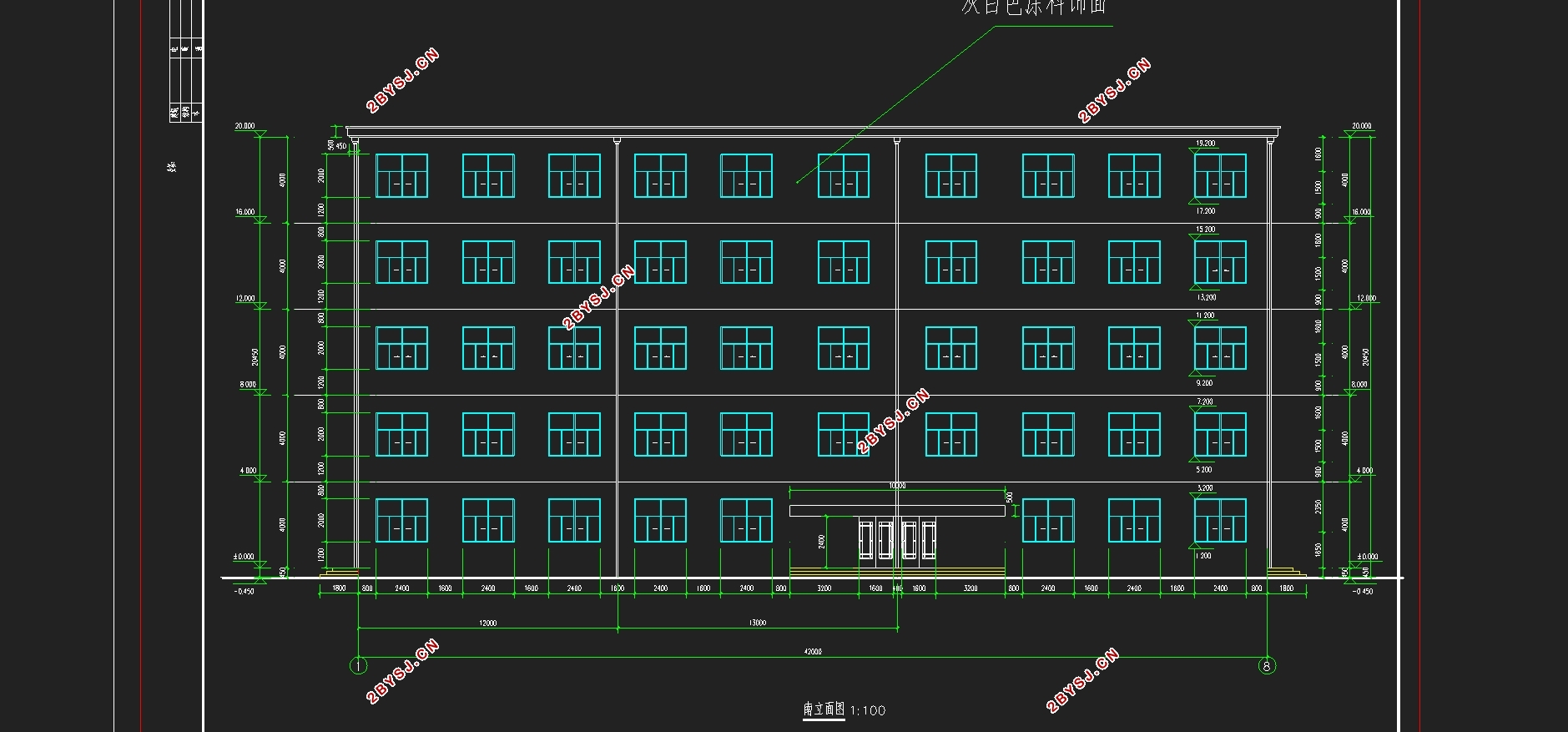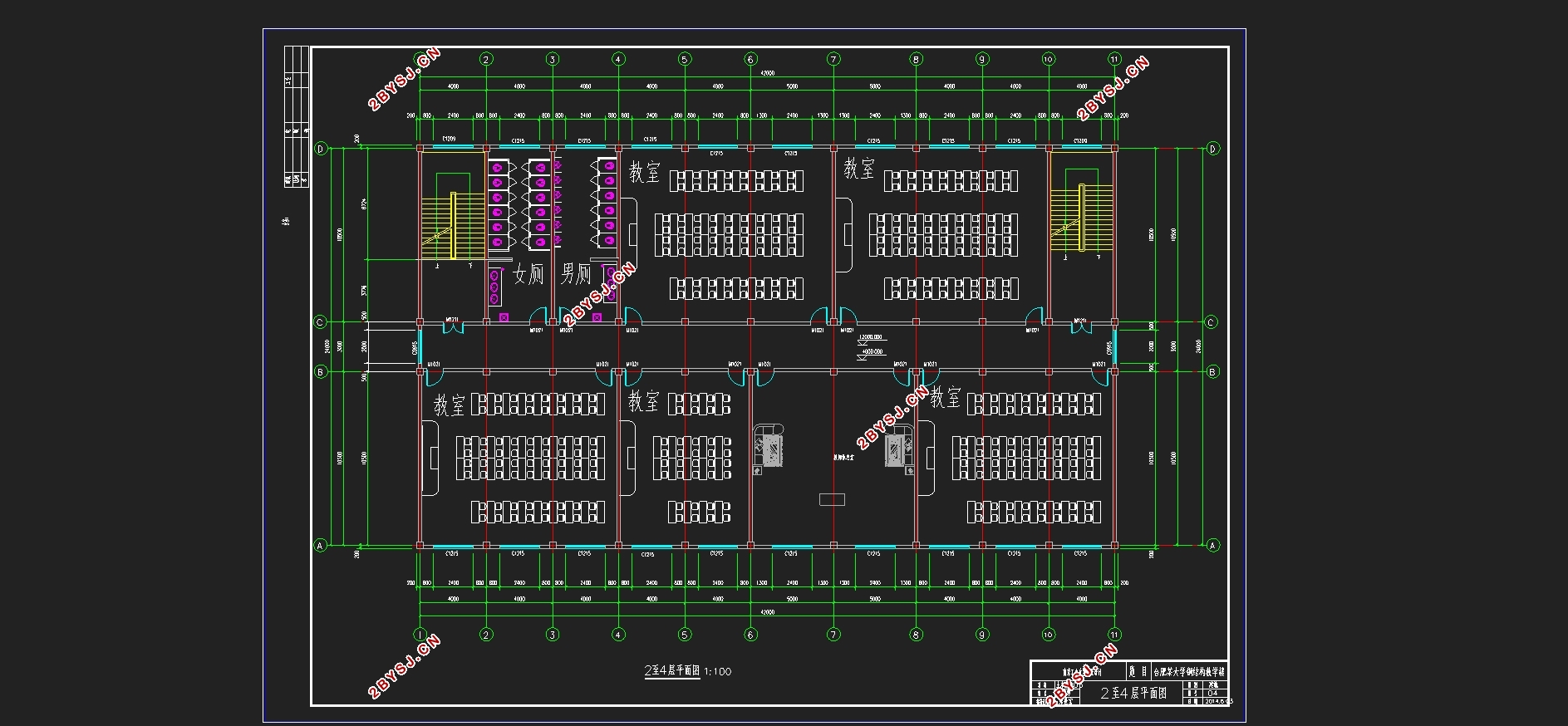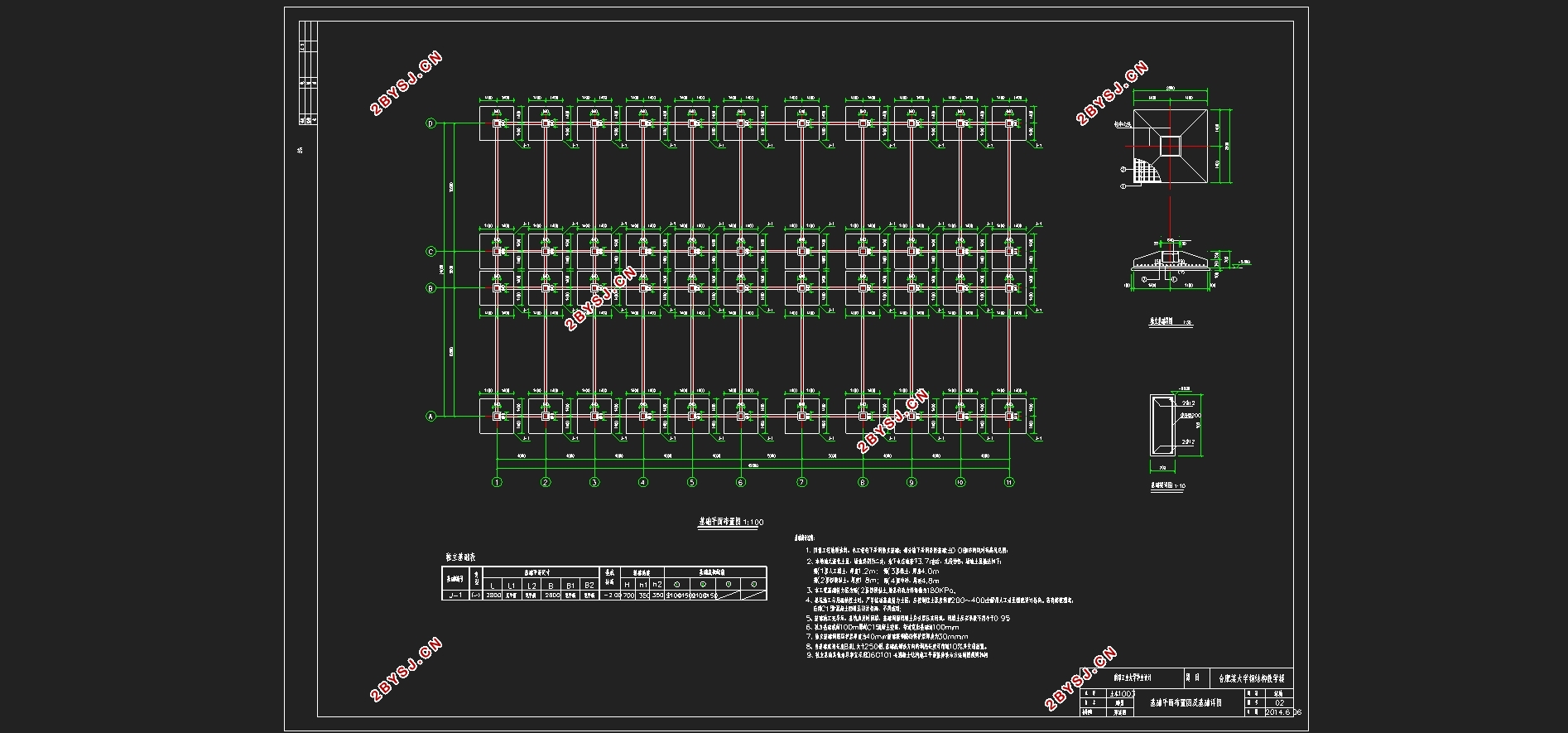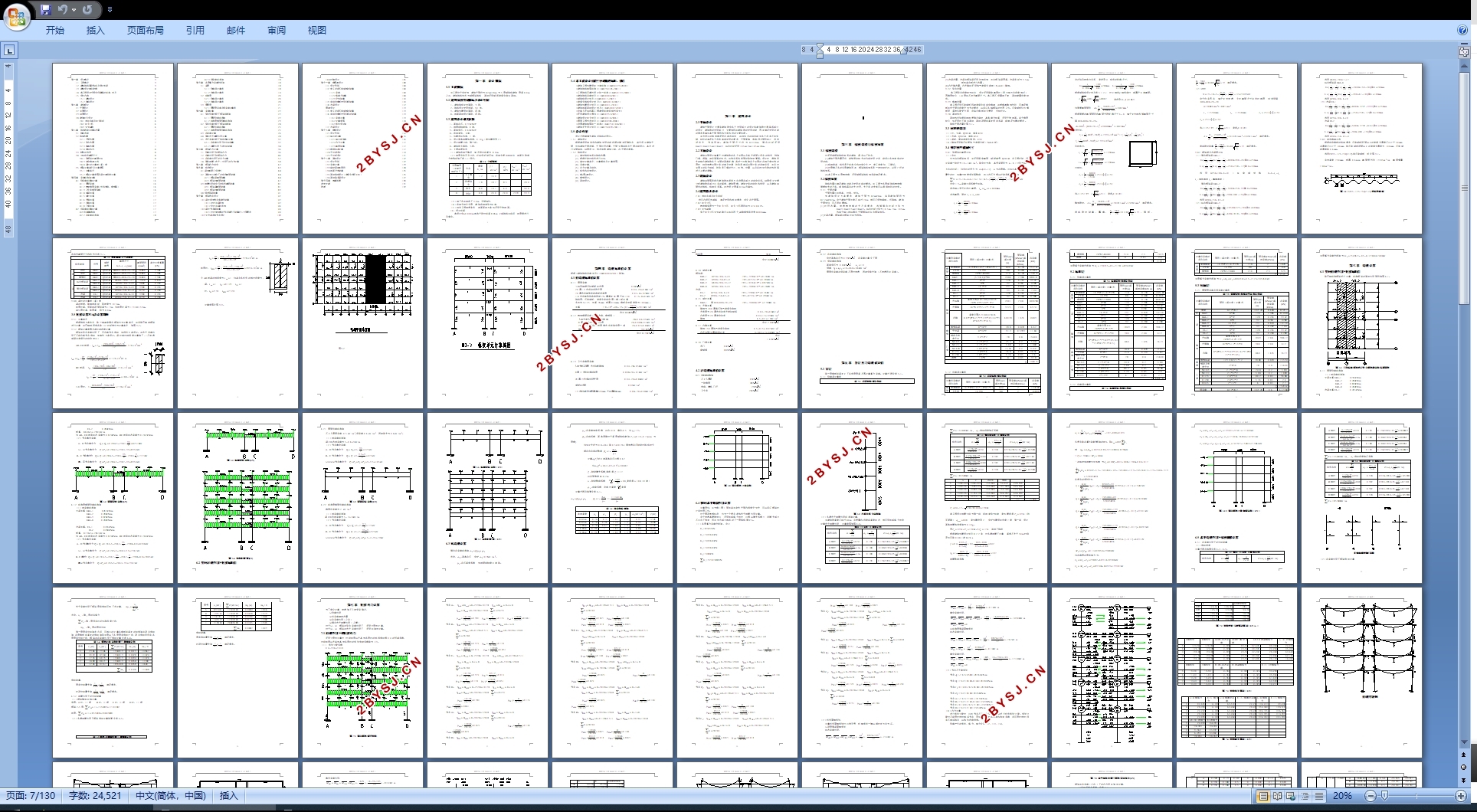五层5040平米合肥某大学钢结构教学楼设计(含建筑结构图)
无需注册登录,支付后按照提示操作即可获取该资料.
五层5040平米合肥某大学钢结构教学楼设计(含建筑结构图)(任务书,开题报告,外文翻译,设计计算书23000字,CAD建筑图10张,CAD结构图11张)
摘要
本工程位于合肥市。主体结构总层数为五层,层高为4m。建筑总高度为21.3m,建筑平面尺寸为42m×24m。抗震设防烈度为 7度,基本地震加速度为 0.10g。
设计内容包括建筑设计部分和结构设计部分。建筑设计部分包括建筑平面图、立面图、剖面图以及建筑说明图。
结构设计时取一榀具有代表性的框架进行设计。结构主体为钢框架结构,由箱型钢柱和H型钢梁构成框架体系。节点的拼接采用栓焊混合连接。楼屋面采用压型钢板-钢筋混凝土非组合楼板,墙体为轻质加气混凝土板。楼梯设计为钢梯,基础为柱下独立基础。结构设计考虑到了结构的抗震性能,在有关地震效应计算时,主要参考国家现行规范。
结构计算内容有荷载计算、内力计算、内力组合、截面计算等几方面。在确定计算简图之后,按照有关设计规范和规定,采用弯矩分配法计算竖向荷载(恒载及活荷载)作用下的结构内力,再进行重力荷载代表值的计算,接着利用顶点位移法求出自振周期,按底部剪力法计算水平地震荷载作用大小,用D值法求出在水平地震作用和风荷载作用下的结构内力(弯矩、剪力、轴力)。由所得的内力进行内力组合,再找出最不利的一组或几组内力组合进行梁、柱的截面设计。截面设计时考虑“强柱弱梁、强剪弱弯”的原则进行内力调整。接着进行楼板、基础的设计,楼板的设计采用双向板设计。基础采用柱下独立基础,基础设计包括荷载计算、基础承载力计算、冲切计算、基础配筋计算等等。
关键词:钢框架结构、节点设计、钢构件设计
Abstract
Located in Hefei, this engineering is a steel structure teaching building which has a main body of five floors. All floors of the building are 4 meters high. The building has a total height of 21.3 meters with a plan view size of 42m×24m. In addition,The earthquake fortifying intensity of this engineering is 7 degree, and the basic earthquake acceleration of the design is 0.10g.
The design content includes architectural design and structural design. Architectural design portion includes floor plans, elevations, sections and architectural description. Architectural design portion includes floor plans, elevations, sections and architectural description. Structure design is done with a representational framework design.
The main form of the structure is steel frame structure box-shaped. Splicing nodes were connected by welding bolt. The pressure plate - non-mix concrete floor slab was applied for the floor roof, light-weight aerated concrete block was selected as walls. Meanwhile, steel stairs were selected in the project. the structural design bases on graduation project requests, such as the capacity of resisting the earthquake.
Structure calculation contents include load calculation, internal force calculation, internal force combination, cross section calculation etc.. After determining the calculation diagram, according to relevant design standards and regulations, The internal force of the structure under vertical load (dead load and live load) is calculated by moment distribution method, the representative value of gravity load is calculated, the free vibration period is solved by vertex displacement method, the horizontal seismic load is calculated by equivalent base shear method, the structural internal forces (moment, shear, axial force) under the action of horizontal earthquake and wind load are solved by the D value method. The internal forces are combined, then the section of beam and column is designed according to the most disadvantaged group or several groups of internal force. The internal forces are adjusted according to the principle of "strong column and weak beam, strong shear and weak bending". Then the floor slab and foundation are designed. Slab is designed according to two-way slabs. The single foundation under column is used. The design of foundation include the calculation of load calculation, the calculation of bearing capacity of foundation, punching calculation and the calculation of foundation reinforcement etc..
Keywords:steel framed structure;the design of connections;the design of steel member
1.1 工程概况
该工程位于合肥市,建筑平面约为42m×24m,为5层钢结构建筑,层高4.0m左右;建筑结构形式为钢框架结构,基础采用钢筋混凝土独立基础。
1.2 建筑结构等级指标及设计年限
1、建筑结构安全等级:二级;
2、结构设计使用年限:50 年;
3、建筑抗震设防等级:丙类;
4、地基基础设计等级:丙级。
1.3 建筑设计相关参数
1、基本风压:0.35 kN/㎡
2、地面粗糙类型:C类;
3、基本雪压:0.60kN/㎡
4、场地类别:Ⅱ类;
5、抗震设防烈度:7 度;
6、设计基本地震加速度:0.10g(查抗震附录2)
7、设计地震分组:第一组;
8、建筑耐火等级:二级;






目录
第一章 设计概况 3
1.1 工程概况 3
1.2 建筑结构等级指标及设计年限 3
1.3 建筑设计相关参数 4
1.4 本工程设计过程中所遵循的标准、规范 4
1.5 设计内容 5
1.5.1 建筑设计 5
1.5.2 结构设计 5
第二章 建筑设计 6
2.1平面设计 6
2.2立面设计 6
2.3剖面设计 6
2.4建筑防火设计 6
2.4.1消防车道及防火间距 6
2.4.2防火分区 6
2.4.3安全疏散 6
第三章 结构选型与结构布置 7
3.1 结构选型 7
3.2结构布置 7
3.2.1 平面布置 7
3.2.2 竖向布置 7
3.2.3 楼盖布置 7
3.2.4 基础形式 8
3.3 材料的选用 8
3.4 初估构件截面尺寸 8
3.4.1 竖框架柱截面初估 8
3.4.3 组合楼盖初选 11
3.4.4 梁柱的计算跨(高)度 12
3.5 框架计算单元及计算简图 12
3.5.1 计算单元 12
3.5.2 框架计算简图及梁柱线刚度计算 12
第四章 荷载标准值计算 16
4.1 恒荷载标准值计算 16
4.1.1 屋面荷载 16
4.1.2 教室楼面荷载(包括走廊、楼梯等) 16
4.1.3 卫生间楼面荷载 16
4.1.4 钢梁自重 17
4.1.5 钢柱自重 17
4.1.6 外墙自重 17
4.1.7 内墙自重 17
4.1.8 门窗自重 17
4.2 活荷载标准值计算 17
4.2.1 活荷载标准值 17
4.2.2 风荷载标准值 18
4.2.3 雪荷载标准值 18
第五章 各层重力荷载代表值 18
5.1 首层 18
5.1.1 恒载项计算表 18
5.1.2 活载项计算表 19
5.2 标准层 20
5.2.1 恒载项计算表 20
5.2.2 活载项计算表 20
5.3 屋面层 21
5.2.1 屋面层荷载及雪荷载计算表 21
第六章 荷载计算 22
6.1 竖向恒载作用下框架标准值 22
6.1.1 屋面恒载标准值 22
6.1.2 标准层楼面恒载标准值 23
6.2 竖向活载作用下框架标准值 24
6.2.1 屋面活载标准值 25
6.2.2 标准层楼面活载标准值 25
6.3 风荷载计算 26
6.4 横向水平地震作用计算 28
6.5 水平荷载作用下结构侧移计算 32
6.5.1 风荷载作用下的位移验算 32
6.5.2 地震作用下的位移验算 34
第七章 框架内力计算 36
7.1 恒载作用下的框架内力 36
7.2 活载作用下的框架内力 46
7.3 风荷载作用下的内力计算 52
7.4 横向地震(水平)作用下的内力计算 58
第八章 框架内力组合 62
第九章 构件设计 63
9.1梁柱截面几何特性 64
9.2 基本效应组合下的构件截面验算 64
9.2.1 框架梁截面验算 64
9.2.2框架柱截面验算 67
9.3地震作用组合下的构件截面验算 81
9.3.1框架梁截面验算 81
9.3.2框架柱截面验算 83
9.4强柱弱梁验算 91
第十章 框架节点设计 92
10.1梁柱刚接节点承载力验算 92
10.1.1边柱与梁连接 92
10.1.2中柱与梁的连接 96
10.2梁柱节点域验算 99
10.2.1对柱壁较薄的节点域进行验算的三方面要求 99
10.3主次梁连接节点设计 103
10.4柱脚设计 105
第十一章 楼屋盖设计 108
11.1设计资料 109
11.2施工阶段压型钢板的验算 109
11.2.1荷载 109
11.2.2承载力验算 109
11.2.3变形验算 110
11.3非组合楼板使用阶段验算 110
11.4次梁设计 112
屋盖设计 113
11.5施工阶段压型钢板的验算 113
11.6非组合楼板使用阶段的验算 113
11.6.1荷载计算 113
11.6.2计算简图 114
11.6.3弯矩设计值 114
11.7次梁设计 115
第十二章 楼梯设计 116
12.1设计资料 116
12.2踏步板计算 116
12.2.1踏步板荷载 116
12.2.2内力计算 117
12.2.3截面验算 117
12.3楼梯斜梁计算 117
12.4平台梁设计 119
12.5平台板设计 121
第十三章 基础设计 122
13.1设计资料 122
13.2荷载计算 123
13.3确定基础底面积 124
13.4地基变形验算 125
13.5基础结构设计(混凝土选用C30) 125
13.6基础联系梁设计 127
第十四章 电算结果 130
参考文献 131
致谢 132
